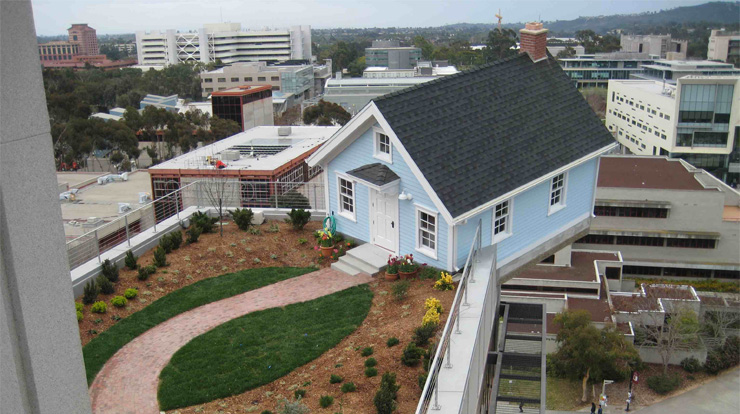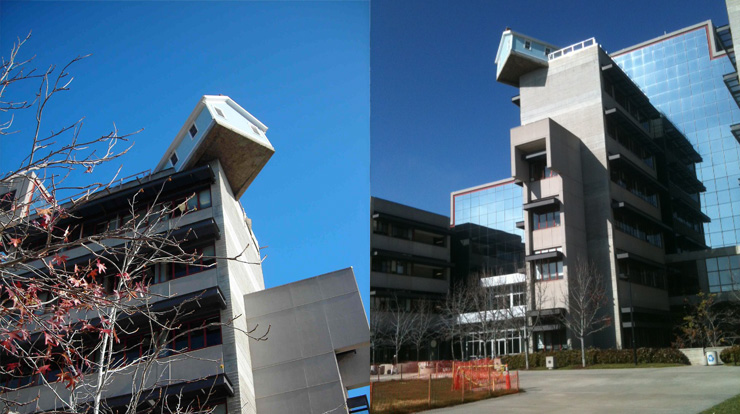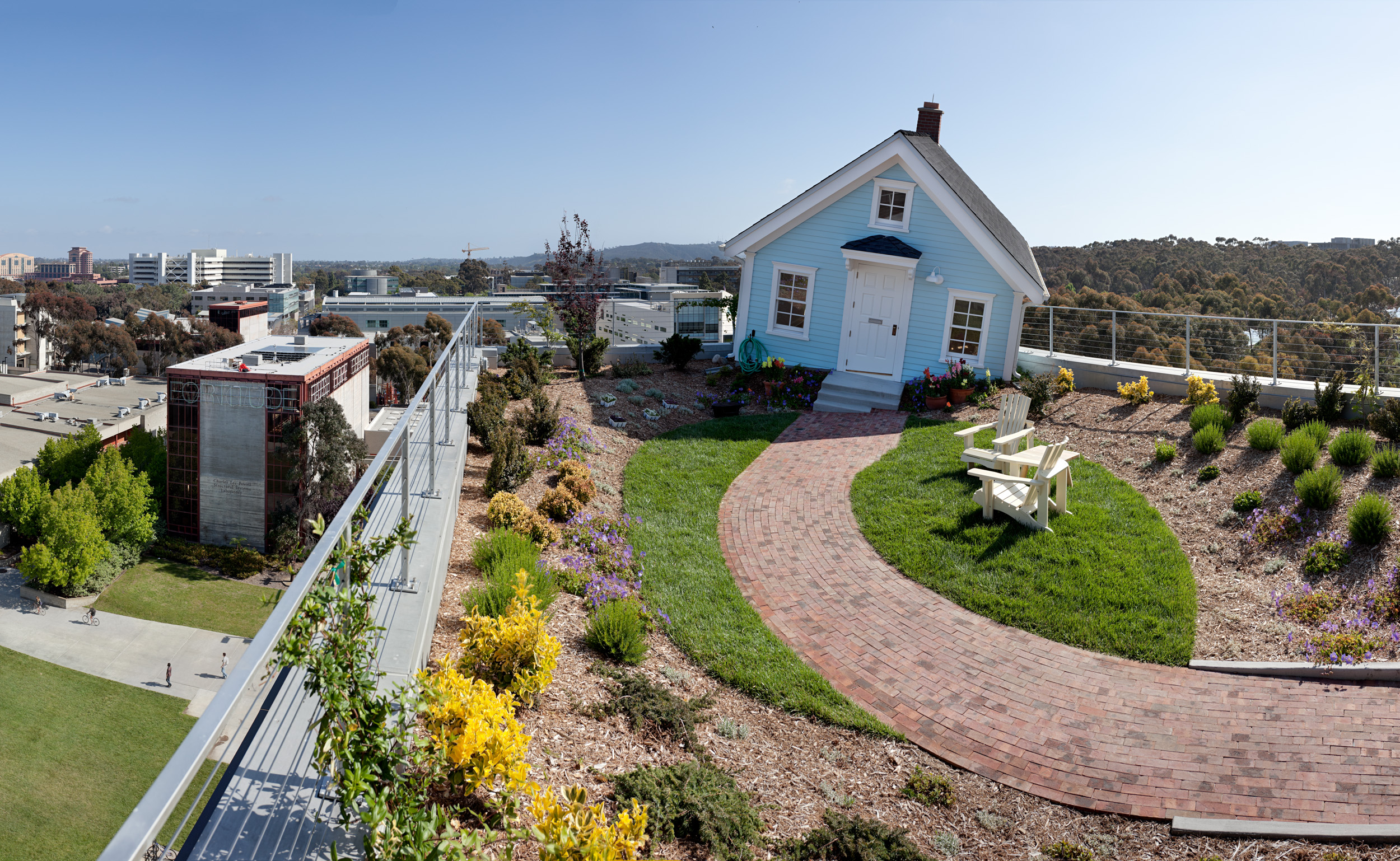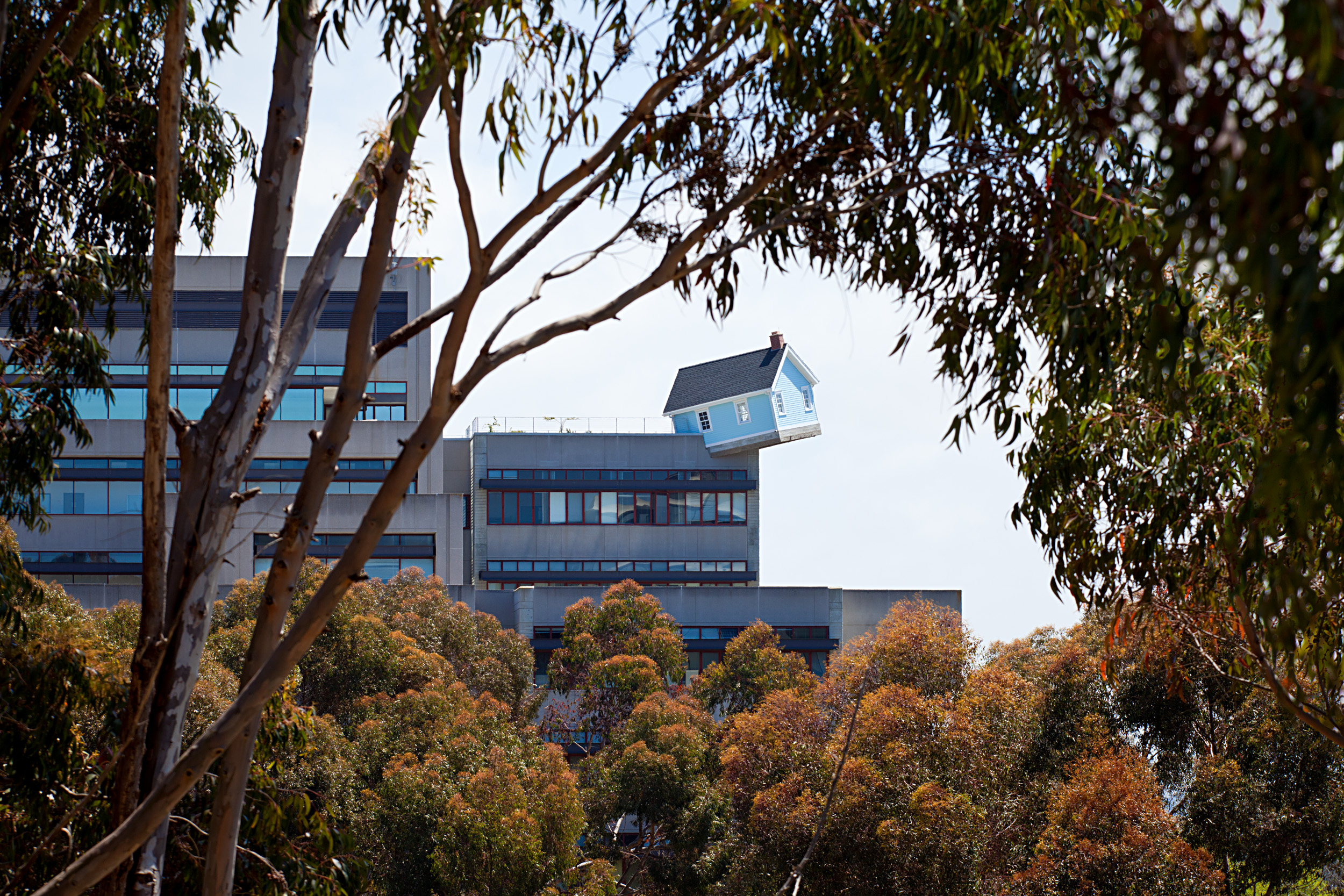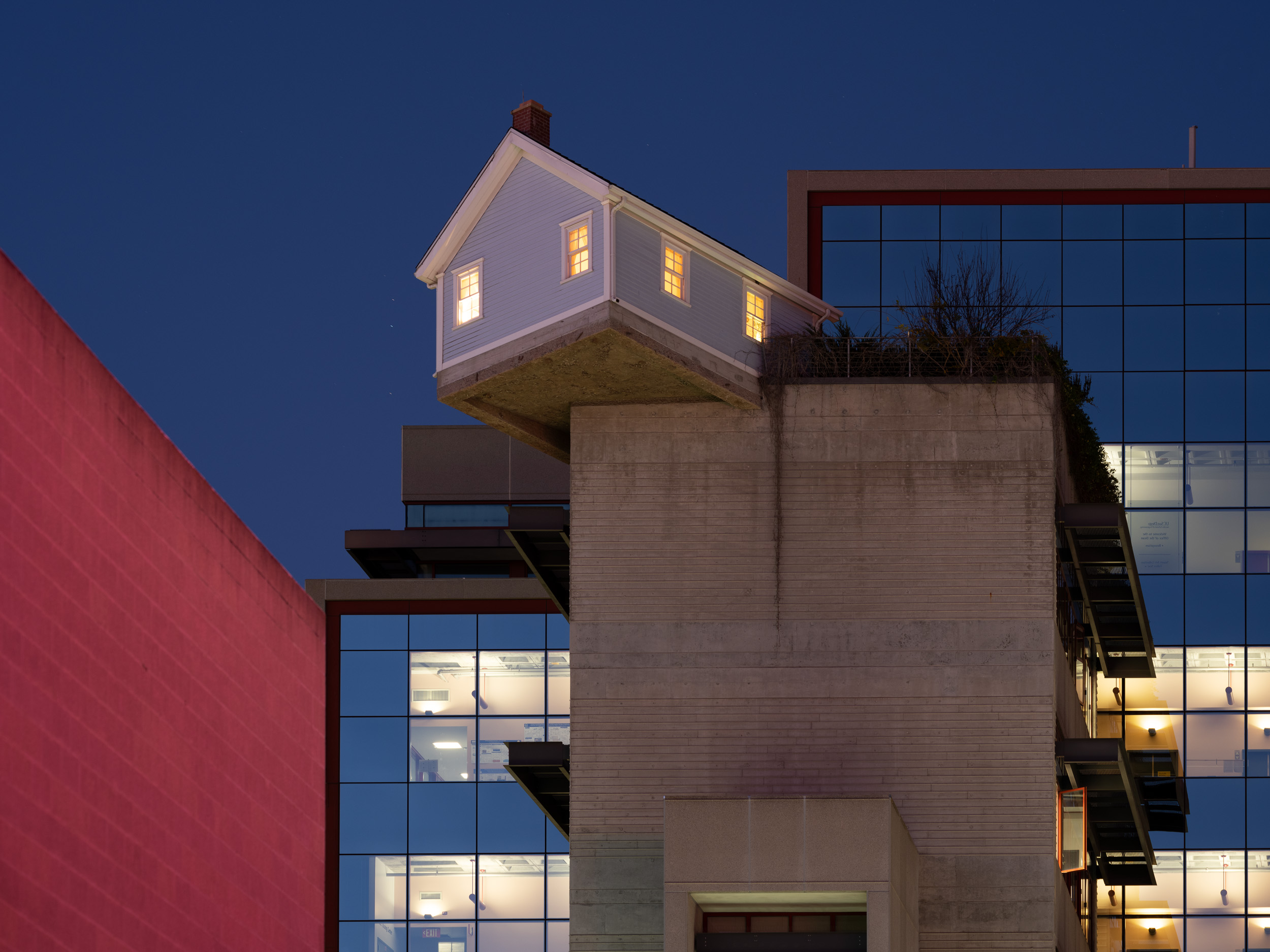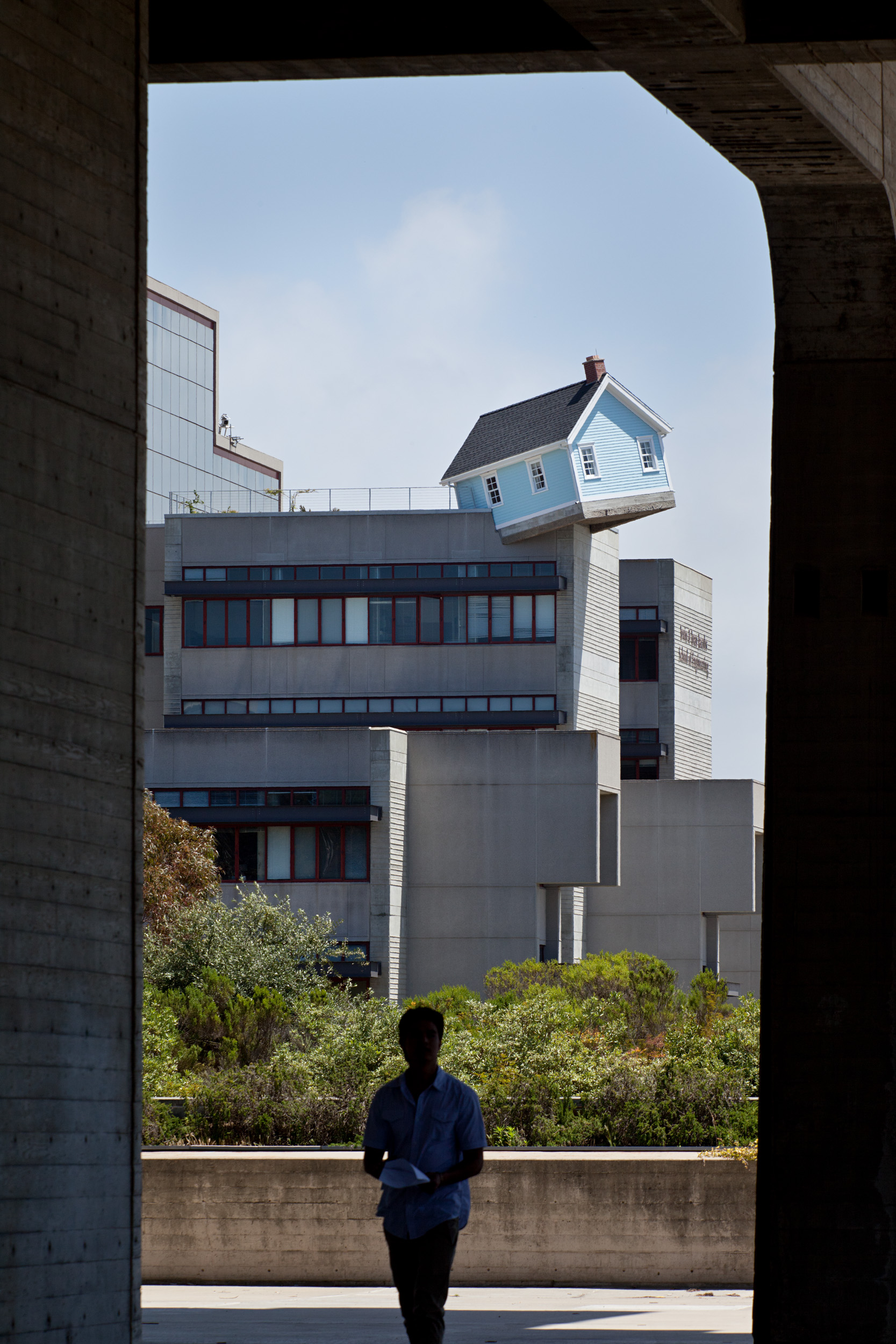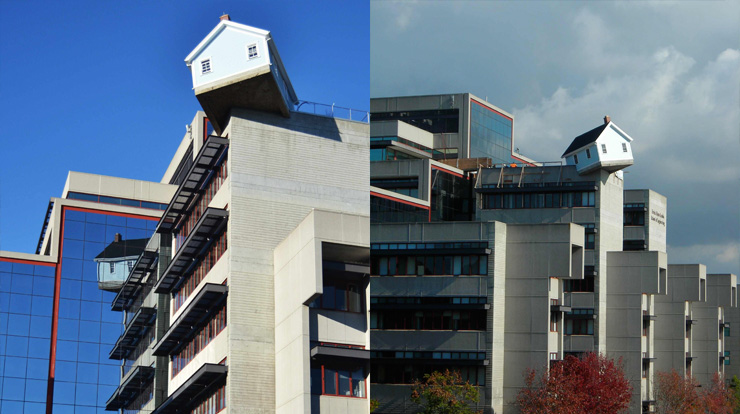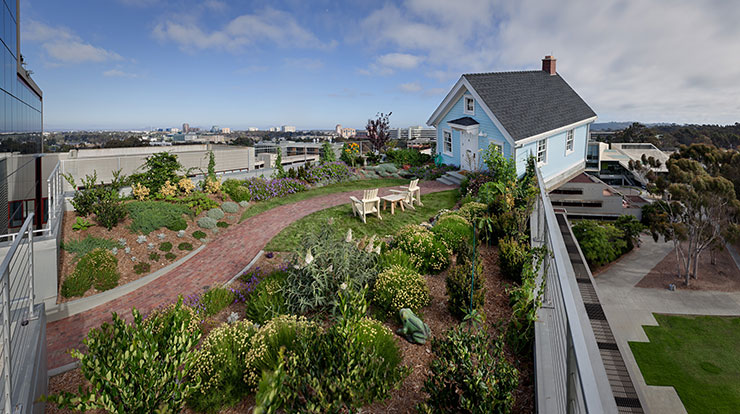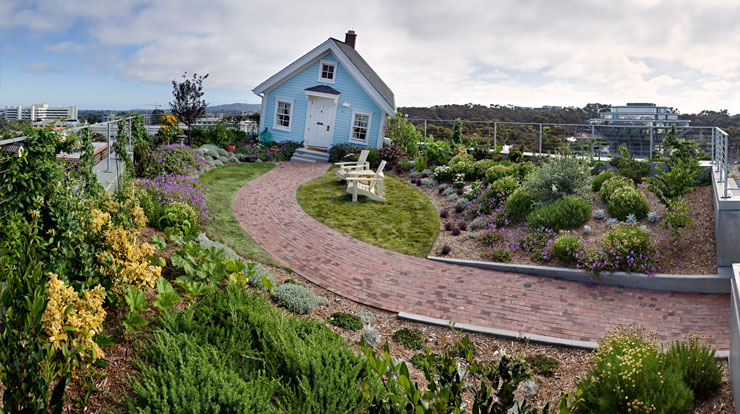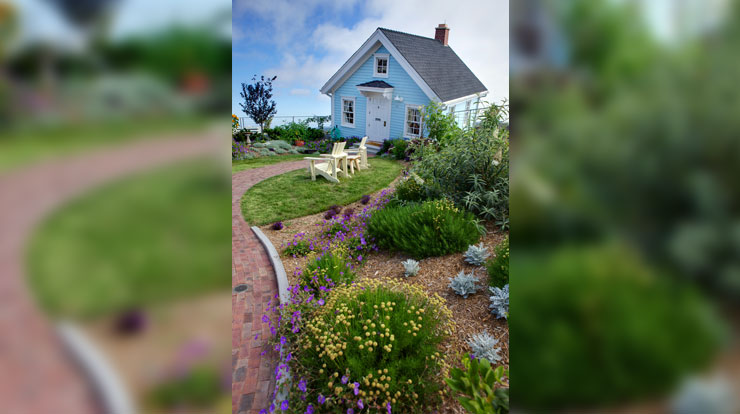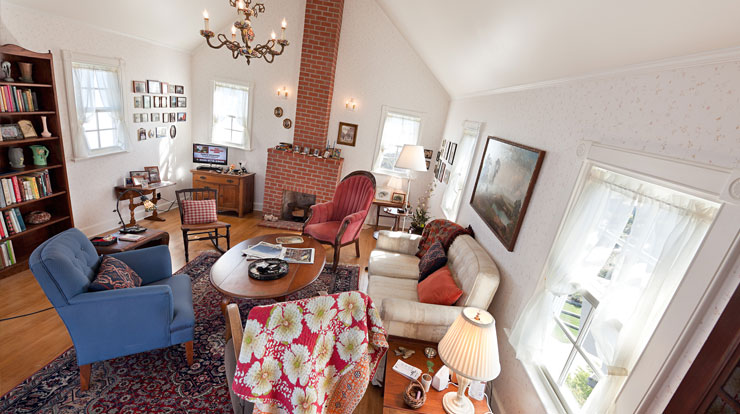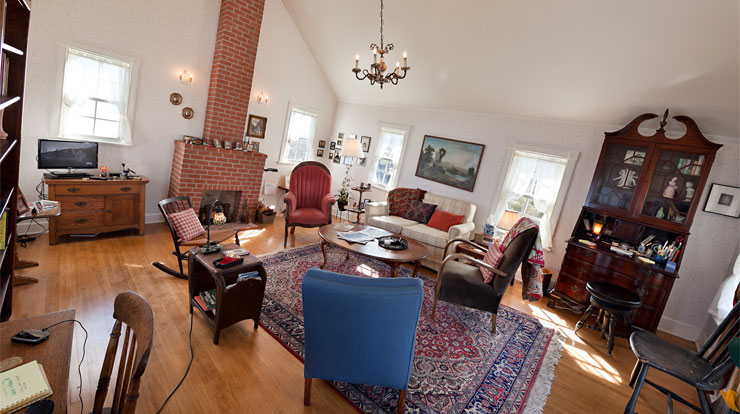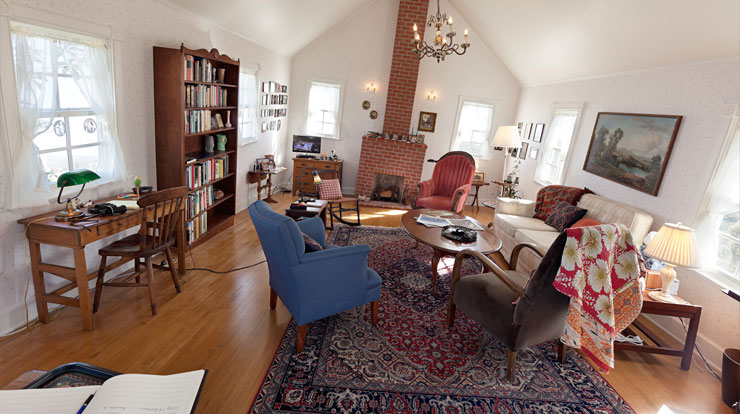Do Ho Suh
Fallen Star (2012)
Location: Jacobs Hall, Warren Mall
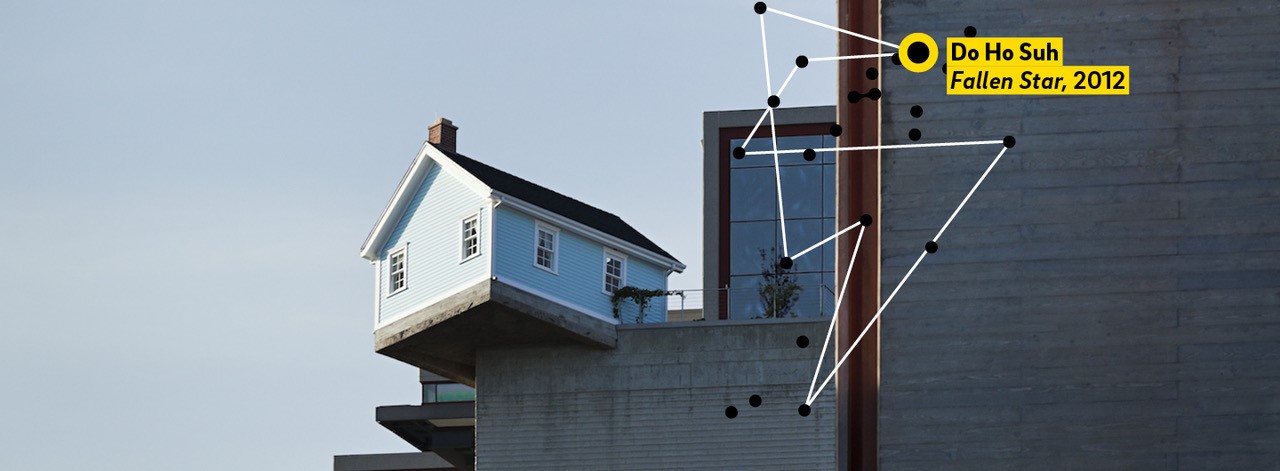
Note: Public visiting hours for Fallen Star are Wednesdays and Thursdays.
Wednesdays are reserved for groups and Thursdays are reserved for individuals or small groups.
About the Artist
Do Ho Suh’s work explores the notions of home, cultural displacement, one’s perception of space and how one builds a memory of it. What is home, after all? A place? An idea? A sentiment? A memory?
These explorations grew out of Suh’s experience when he arrived in the U.S. in the early 90's to study at the Rhode Island School of Design. His own feelings of displacement (as if he had been “dropped from the sky”) led him to measure the spaces around him in order to establish relationships with his new surroundings. He had to adjust – physically and mentally.
He made sheer fabric replicas of his home in Seoul and his subsequent American apartments. He had the notion that he could pack these “homes” up and take them with him. They would be physical, tangible homes, but fully transportable. This can be seen as particularly relevant in the context of increasing global mobility and for a university campus where many students, faculty and staff have come from elsewhere to study and work. These ideas become evident, even poignant, in the experience of Fallen Star, Suh’s project for the Stuart Collection.
Do Ho Suh was born in Korea and attended Seoul National University. He earned a BFA in painting from the Rhode Island School of Design and an MFA in sculpture from Yale University. His works are in museum collections around the world, including the Museum of Modern Art; the Whitney Museum of American Art; the Solomon R. Guggenheim Museum; the Walker Art Center; the Tate Modern; Artsonje Center, Seoul; the Mori Art Museum, Tokyo; and the Leeum Samsung Museum of Art in Seoul, Korea. He represented Korea at the Venice Biennale in 2001. Suh lives and works in New York, London and Seoul.
About the Artwork
A small cottage has been picked up, as if by some mysterious force, and “landed” atop Jacobs Hall, where it sits crookedly on one corner, cantilevered out over the ground seven stories below. A lush roof garden of vines, flowers and vegetables, frequented by birds and bees, is a small gathering place with panoramic views of the campus and beyond. Upon entering the house it becomes apparent that the floor and the house itself are at different angles, causing a sense of dislocation – some would say vertigo. One must adjust both physically and mentally in order to accommodate a whole new view of the world. The surroundings are familiar but the feeling is not.
There are many “family” pictures on the wall and tables – Do Ho with his family, and others, many connected to the project – forming a kind of extended family unique to this Fallen Star. The house is fully furnished, with a fireplace, collectibles, art, children’s drawings, a clock, a radio, a TV, and all the clutter one expects at home. The house can be viewed from a distance, or from down below and from the inside of the building. There is a startling sense of wonder when one spots Fallen Star: What is it? How did it get there? It invites us to take a closer look.
Essay
Do Ho Suh, Fallen Star, 2012
After following Do Ho Suh’s work for a number of years, we invited him to visit and talk about a possible proposal in 2006. I had recently seen one of his silk houses at PS1 in New York and was blown away. It was hanging, a gorgeous celadon color, and it was truly moving. It turned out to be a “replica” of the skin of the house where he grew up in Seoul, Korea.
Do Ho’s work explores notions of scale, site specificity, cultural displacement, one’s perception of private and public space, and how one builds a memory of it. What is home, after all—a place, idea, sentiment, or memory? These explorations grew out of his experience when he arrived in the U.S. in the early ’90s to study at the Rhode Island School of Design. Do Ho’s own feelings of displacement (“as if he had been dropped from the sky”) led him to measure the spaces around him in order to establish relationships with his new surroundings.
He made sheer fabric replicas of his home in Seoul and subsequent American apartments. He imagined that these “homes” would be fully transportable—that he could pack them up and take them with him. This can be seen as especially relevant in the context of increasing global mobility, and for a university campus where many students, faculty, and staff have come from elsewhere to study and work. These ideas become evident, even poignant, in the experience of Fallen Star.
After exploring the campus and talking over various ideas, Do Ho sent along drawings and models: the first was a half-scale Korean house and garden of his childhood on the back of a large Fruehauf flatbed semi-trailer, implanted into a berm somewhere on campus, having been driven, Do Ho imagined, all the way from Seoul to California. This turned out to be the more seemingly feasible of his two ideas. The second, Fallen Star, was for a house inserted into the side of a building, high up. On the inside, this slightly scaled-down house would have its domestic interior juxtaposed with the institutional architecture of wherever it had “landed.” The house idea was astounding. I hesitated for a few moments thinking about money. How would I ever find it? Mathieu Gregoire pressed on, “This would be so amazing, we must do it.” We agreed to move forward with the search for a building that might possibly work. It was important that this building have a tall, clear, modern façade.
We started with Urey Hall, one of the first buildings on campus, which houses many life science labs. It was important that people be able to enter the house. With the help of Do Ho Suh studio’s extensive electronic and physical modeling capabilities, we created a 3-D model of Urey with the house inserted into the seventh floor. After objections from faculty who were not keen on public exposure to their labs, we moved on. As with many Stuart Collection projects, when big obstacles arise, the art tends to become more integrated and nuanced.
Do Ho was quite flexible about a variety of site options, asking that we look around and photograph any and all possibilities. He made rough sketches for the Student Services Center and the Price Center East, where the architect entreated us to please not propose this intervention. In any case neither of these buildings had the height that seemed important to this ”flying” house. UC San Diego, having grown horizontally across its 1,200 acres, is actually quite limited when it comes to tall, simple, modern architecture. Another major limitation was the appropriation, even if artistic, of existing interior space that was already someone’s office or laboratory. Looking up at one of the few buildings, then called EBU–1, that was architecturally appropriate, all of the projecting corners were faculty offices. Not a welcoming prospect. But the roof of this building came to mind: what if the house could insert itself at the roof level, with the possibility of a front yard—a roof garden—spilling out from it? Maybe Do Ho could combine his idea of the garden on the flatbed trailer with a house coming into a corner of this building.
Do Ho was initially skeptical. The idea of the two interior architectures—domestic and institutional—being juxtaposed was very important to him. But in his open, thoughtful, and gracious way, he came to like the idea, and the sense that this traveling house would make a place for itself with a New England garden spilling out across the roof of this 1980s building.
We met with the chancellor, UC President Emeritus Richard Atkinson, and then with the dean of engineering. All were interested and open. Most important, we needed to have Joan and Irwin Jacobs agree to this startling intervention into the newly named Jacobs Hall. After consideration, they agreed to the idea and eventually became enthusiastic supporters.
Do Ho, with his unique combination of openness and precision, sent three possible solutions; one with a horizontal house sticking straight out of the building; another with an upended (and inaccessible) house crashed vertically into the roof; and a third with the house angled downward into the corner of the roof. The angled house worked best from the exterior views, and it would also be possible to enter it. We built a full-scale mockup of the walls and floor of the house in a parking lot, and tried various angles for the floor in relation to the walls and windows in order to get it right. The difference between the angles of floor and walls would became an integral part of the design and eventual experience of the interior.
With these basics solved we engaged three designers who became essential to the project—Hodges & Hodges Architects, Walsh Structural Engineering, and Spurlock Landscape Architects. Then engineering dean Frieder Seible proposed a concrete slab solution that created a much more realistic effect—a house that really looked like it had raised itself right out of the ground. Like many seemingly simple ideas (the nearby Snake Path and Bear come to mind), the design, modeling, and detailing were extremely complex. The house needed to look like it had dropped out of the sky and seamlessly joined with a building that dated back to 1987. The problems ranged from bureaucratic (the building had originally been funded by a bond measure that put UC San Diego’s legal ownership into question) to structural (the older building had to be analyzed and the roof reinforced by post-tensioning). And the house itself had to look just like the modest New England cottage Do Ho had known in his neighborhood in Providence, RI. The sheer improbability of the whole enterprise drove everyone forward.
Construction began in June of 2011, and we were fortunate to have the same capable contractor working on it that had constructed Tim Hawkinson’s Bear—Pacific Southwest Structures. The house was built on the ground in front of the building. Its unique angles and fit to the existing building were confounding, and contractor, structural engineer, and architect worked together brilliantly, motivated in part by the sheer uniqueness and challenge of the project.
On November 15, 2011, the house was raised to the roof in a complicated and highly orchestrated operation. Do Ho was here, of course, along with a film crew that he had assembled that had placed some fifty cameras in multiple locations to capture the maneuver. It took hours to find the center of gravity for this eccentric structure. Finally, about noon, it “flew,” slowly and steadily to the roof. Do Ho said, “Mary, my heart is coming out of my mouth.” This was a dream come true for him. We cracked the champagne.
Then the interior work began: the floor, rug, wallpaper, bookshelves, furniture, and a hundred or more items and collections were selected and placed to fully furnish and make it into a “home.” San Diego, with its mobile military and tech-related populations, has a wide choice of used and antique furniture consignment stores. We enlisted our friends and the project team to seek out furnishings, all of which had to be slightly smaller than full size. In consultation with Do Ho, we bought everything and set it up in a lab in the building, where he, on his next visit, was able to choose from this mixed and matched array of objects to create the interior assemblage that made most sense to him. The selection and arrangement of objects created its own set of possible narratives, just like any house interior that has been lived in for years.
We opened Fallen Star to the public on June 7, 2012. There were literally thousands lined up all day, and the event ended up going viral on TV and online. Since that time, many more thousands have visited, including many who have been drawn to the campus by seeing it from miles away.
Everything is slightly scaled down in this little cottage that has been picked up by some mysterious force and “landed” atop Jacobs Hall, where it sits crookedly on one corner, cantilevered over the ground seven stories below. A lush roof garden is a small gathering place with panoramic views of the campus and beyond. Upon entering the house it becomes apparent that the floor and the house itself are at different angles, causing a loss of equilibrium (some would say vertigo) and a sense of dislocation. One must adjust both physically and mentally to take in an altered view of the world both inside and outside. Interestingly, when one sits down and focuses on other people in conversation, any loss of equilibrium disappears. Personal connection overcomes physical instability.
There are many pictures on the walls and tables—Do Ho with his family and others connected to the project, including a childhood photo of every dean of engineering since the school’s beginning. There is a fireplace, full bookshelves, desks, a working television, collections of small toys and silhouettes, and all the clutter one expects at home. Lights come on and off at night as if someone were living there. From below and from far away, seeing the small blue house up there causes incredulity, awe, and wonder, which only increases as one approaches, goes up into the building, and discovers that it is indeed a real house, with a real interior and sense of home. It is both monumental and personal, mirroring in its way the journey of the thousands of new students arriving at this growing institution every year.
Interview with the Artist
Fallen Star (2012 ): Do Ho Suh and Joan Simon
JS: Why is your work titled Fallen Star?
DHO: It’s like something out of the sky. It’s the translation of the Korean words for—what is it? Not the comet. The shooting star. Basically a shooting start that came from the outer world. We always wonder if there’s alien life there, so it’s about displacement. The Korean term means something like habitable place that just fell from the sky and landed somewhere. Instead of using a more technical term, I used Fallen Star as the title.
JS: In earlier works you’ve referenced your own homes, notably in the suspended. almost ghostly replicas made of thin, translucent, diaphanous textiles. You’ve used a different form of house in the Stuart Collection commission.
DHS: I started to use the title Fallen Star at an artist’s residency in San Antonio [Artpace] in 2006. I made a piece that was probably a 1-to-8 scale model of my first American home in Providence and also my childhood Korean home. The Providence home crashed onto the Korean home. That was the first time I made something about this falling star. Two distinctly different architectural stars clashed.
JS: Other of your works bear the same title.
DHS: I made different variations of the same Fallen Star in 2006 and, actually, I submitted my proposal to the Stuart Collection when I was in San Antonio. I visited the Stuart Collection all year that year. I have to double check the timeline. It seems that it was 2006. At this time I was quite occupied with the idea of this alien building just traveling long distance and crashing into wherever it landed. I remember I made a sketch and sent it to Mary by email.
JS: One of the related Fallen Star paper works is a drawing you did on newspaper.
DHS: Are you looking at my drawing book?
JS: Yes. The drawing is on p. 16.
DHS: I was also interested in this unknown force. You can call it, maybe, fate but it is the force that brings change or changes the course of your life. And so I was basically drawing something on the image of the tornado that I found in the newspaper. I guess I was traveling somewhere and reading this newspaper on the airplane or in the hotel room. And I placed the house on the tornado. I think it has two pages.
JS: It does.
DHS: On both pages I was exploring this whole idea of the unknown force that changes.
JS: On the large photo of the tornado are the words “Weathering the storm of climate change.”
DHS: That was the title of the article in the newspaper. The Wind of Destiny was my title of the drawing.
When you watch the Mary Poppins movie, she lands when the direction of the wind changes. She leaves also when the wind changes. So it’s nature. In my culture in Korea when something changes, when there are big changes in your life, we often describe it as, “Oh, you know, the direction of the wind has changed.”
JS: Among the most memorable scenes in The Wizard of Oz are the tornado lifting Dorothy’s Kansas home and the house crashing elsewhere, dropping onto the Wicked Witch of the East in the land of Oz. Was that something you had in mind?
DHS: No. Perhaps subconsciously. When I was perceiving this idea it was not related to The Wizard of Oz, though people made that connection. I was thinking of Alice in Wonderland, actually. The story begins with the main character displaced. I guess it shares a similar idea.
JS: The displacement in both The Wizard of Oz and Alice in Wonderland has to do with the kind of transport, transposition, in dreams--from an everyday world to an imagined place.
DHS: For me, it was some kind of device--a fantasy story, a great excuse in a way. They dreamt, and anything could happen in a dream. For me, in a way, I wasn’t sure. I’ve been reading that story to my daughters in different versions in children’s books. I’m not sure she dreamt. It’s not relevant to my work.
JS: In your drawing book, reproduced next to the newspaper diptych Fallen Star: Wind of Destiny (Herald Tribune Version) is another rendering of your idea of an unknown force and the displacement of a house, with multiple renditions of a tornado funnel: Fallen Star: Wind of Destiny (Artpace Version).
DH: The blue drawing on that page--that’s exactly when I was working on the Stuart Collection project.
JS: How did your concept for the Stuart Collection begin to take form and how did it evolve?
DHS: The beginning of that year 2006 I visited San Diego and the campus. Mary and Mathieu drove me around the campus and to other places. At the beginning I wanted to find a site where you actually see the Pacific Ocean. So obviously, that had to be near the coast. I realized later that was not part of the campus, but at the beginning that was my idea. To be near the coast, actually be able to see the ocean.
I remember Mathieu told me when I was describing my ideal site for the project, “There’s a perfect site for it, but it’s taken. I’m going to show it to you anyhow.” He took me to that site, a science building [the Salk Institute, designed by Louis Kahn] and I realized why he wanted to show me that building though it was not available to me. The coastline, the cliff that that drops off, and you see the Pacific Ocean. It could have been the perfect site for my project hanging at the edge of the cliff.
So before I went to that building I was thinking about that coast line, the Pacific Ocean-- that it was the closest part of the States to Korea. I was thinking of the huge Korean population in L.A. and the one and only thing between L.A. and Korea is the Pacific Ocean. I was thinking of the edge of the cliff and something like a springboard that goes out of the cliff and then at the end of the springboard—or jetty, you may call it a jetty—there’s a small house.
The idea was the building, your house, is close to your original home, but you cannot go that far out, because of the gravity and the structural restrictions. I instantly realized that doing something on the cliff was too far from the campus and couldn’t be done. I had to redirect my focus to the campus.
We just walked and drove, trying to get inspiration. And then I was quite struck by the size of the campus. It's a huge place and you see the traffic, you see so many people, students gong from one class to another. And then I just realized that all left home to go to the university. For most of the students it’s probably the fist time they’ve left their homes.
During my first visit, I saw that the student body and the people who work there don’t necessarily come from that area. They come to this environment that was created by someone else. I wanted to address the people who had been displaced to get to this campus. That’s how I left San Diego after my first visit.
A few months after I went back to San Antonio, I came up with the idea of the Fallen Star for the Stuart Collection. At that time basically it was pretty open. I could propose anything anywhere on the campus. I didn’t have any specific building for my project. I just wanted to put into it this little cottage from the East coast.
JS: Why the East coast?
DHS: In the U.S. I was living on the East coast pretty much the whole time. Obviously you see the difference between the landscape and the architecture of the West and East coasts. Sometimes that -- from East coast to West coast-- feels even more far away than the U.S. to Korea.
JS: Why?
DHS: Sometimes its combine of culture and geographic distance is more different than America and Korea. I also think of the huge differences when it comes to public art. I can talk about anything in gallery or museum exhibitions. In the museum spaces, my practice in general is coming from my very personal experience. When it comes to public art you have a different audience-- I would say, even a much broader one than the audience who would go to the museum and see my work there.
This cottage from Providence was not something I found from a photograph on the Internet. It was something I was passing by in Providence for three years. It was something I translated and transported. Something I was familiar with but used at a different architectural scale.
When I was a student at RISD [Rhode Island School of Design], I was living on Benefit Street, and on Benefit Street there are many luxurious mansions, including historical buildings built in the 1700s. The main RISD campus is on Benefit Street but as you go out from the campus the buildings and houses get less fancy. The cottage I passed everyday was originally a beautiful building but it was renovated to accommodate students. It was a few buildings from where I lived. And so this cottage that I have modeled after was one of those modest buildings.
JS: In a sense you have transported a house related in your memory from one campus—on the East coast—to another campus, on the West coast.
DHS: That’s interesting. I didn’t think of that and the house was not on the campus. The RISD campus is much smaller than UCSD campus. It is more blended with the rest of Providence, so we call it campus, but in a normal sense RISD is not a normal campus. This cottage was on the street where I lived, but really it was farther away the school even though they were both on Benefit Street.
JS: Fallen Star is of course on the UCSD campus, atop the Jacobs building.
DHS: That’s a school of engineering. And certainly the project was an engineering challenge.
It’s interesting when I look back. I never thought the project would be realized. When I proposed this idea to the Stuart Collection, they came up with several candidate buildings. I forgot the names—maybe a physics or science building. At the end, basically, nothing was possible. Nothing was available.
One interesting episode before the engineering school came forth was the possibility of a student center that back then was not built but designed and was going to be built. They suggested maybe I place my piece on the student center. I thought the architect would be pretty upset about it. A total stranger, this artist, came and plugged this small house into his design. I would very upset if I were him. I expressed my concern to Mary and Mathieu. “Let’s see how it goes” was their thought. Afterward, they told me the architect was very polite and very upset.
Several years passed—almost like four years we were waiting. The dean of the engineering school was intrigued by the concept, he himself was a structural engineer, and he offered the rooftop of his building [the Irwin and Joan Jacobs School of Engineering]. We had a structural engineer for the project, but he also got involved for the engineering of the piece. It took a very long time and route to get there. I really want to give credit to Mary and Mathieu. Those guys never gave up. They talked to everybody.
JS: Fallen Star is not only on the roof, but also cantilevers out from the building 100 feet above street level. How do people gain entry to the cottage itself?
DHS: Once we had the Jacobs building, my first idea was sticking this house on the side of the building but that was not possible. And when we decided on the rooftop, there was a flat area where I could do something, and I could put the house on the edge of the rooftop. Instead of leaving that roof as it was and not doing anything there, I decided to incorporate that space into my project and make a garden. The final concept didn’t come across as compromised, because I really liked the idea of creating a garden.
So the cottage somehow landed at the corner at the edge of the rooftop and when the house was lifted by this unknown force from Providence, the house carried the things from the ground, and then when it landed, it spread the plants or flowers that came with the house. So that was the narrative. A house and its context traveled together, and then it tried to survive in this foreign soil.
The narrative changed because of the differences in climate. San Diego is different from Providence and so some of the trees or plants could survive but a lot could not. I worked with a landscape architect and we made a list of the plants you can find in Providence and San Diego. Somehow, some of those things have been climatized on both coasts. The list we created for the garden had all the plants and trees that we could find on the East coast that also could survive on the West coast. It was fun to select those plants for the garden.
JS: Please talk about the house itself.
DHS: The Providence house was a very small cottage and I scaled it down to fit on the site. Then I tilted it. When you go into the house the floor is not leveled. The rooftop is actually on the seventh floor of the building. The house is coming out of the edge of the building, so you’re basically up in the air, and the floor is tilted. So as you enter it you completely lose a sense of balance. A lot of people, including me, experience a sort of vertigo. Your body physically responds to this uneven floor and on top of that you are seven stories up in the air so that psychological thing accentuates the sense of –what do you call it? —
JS: Disorientation?
DHS: Yes. Disorientation. It’s quite powerful. Even the furniture and objects in the house are all at angles. The chandelier in the middle is the only thing that is plum. When you are standing there it doesn’t look like it’s plumb. It’s a strange sensation.
The important thing for me was that I wanted to create public art that is something you can go into, instead of looking at it from the outside. I wanted something that is interactive. You can experience both inside and outside of the work. And when you go in there you are part of the piece. I wanted a different kind of relationship with the audience than typical monumental public art.
In the first proposal for the house on the side of the building, I wanted to connect domestic space and this public institutional space and blur those boundaries, which didn’t happen. The final piece also has different dimensions from the ones we couldn’t deliver in the original proposal. I like the fact that the garden is an intermediate space between the engineering building’s space and the cottage’s-- and delays entry to the cottage.
When you go to the seventh floor of the building, you see the garden through the glass door before you enter. It is just unreal to see that type of garden and the house on top of the campus building. Maybe it takes three minutes to get from the engineering building to the entrance door to the cottage but that passage helps to prepare you to enter a different world. There’s a bit of delay and you are entering this miniaturized space that looks like someone has been living there.
The cottage is maybe 75 % the size of the actual building in Providence. So everything is scaled 25 % smaller. We chose smaller scale furniture, and brought in all the objects. We didn’t make anything.
One thing I should mention: I asked Mary and Mathieu to bring something from their lives as well. Also they asked people who were involved to bring photographs and small objects, so we put those together to create a room like in someone’s home. It consisted of objects from so many different people.
For me it was a very interesting and very difficult part of the project. I was creating a living space. I always work with the space that I have lived in, but this is something else. It’s not even someone else’s home. It’s just an imaginary home. It was not from one specific home.
It was based on the research that I did about typical American homes. I gave references to Mathieu from so many different homes. I want this kind of furniture and this kind of carpet from the pictures I found on the Internet. That was a kind of loose guide for Mathieu to find these kind of things. And then there were the things people brought to the project. Mary brought her childhood photographs and also the chair that her grandmother gave to her. A lot of people brought books and photos. I contributed my photograph of my daughter’s first birthday and also I drew some drawings on the notepad in the house.
So it was a composite of many different things and it’s interesting that many people look after the garden.
JS: Who are they?
DHS: The Stuart Collection has a caretaker who looks after all the projects, but a couple of Mary’s friends stop by and do the watering and sometimes they plant tomato plants and flowers. So it’s really beautiful to see how the garden has evolved over the years.
It really feels like somebody actually lives there. The cottage has a fireplace and chimney, which is not a functional fireplace because of safety reasons. But inside of the chimney we put the artificial smoke generator and also we have a timer for the lights. So after 6 p.m. the lights go on. And then you see the smoke going out of the chimney. You can really have a sense of somebody living inside.
JS: The path between the Jacobs building and your house?
DHS: It’s actually brick. And the path is an “S” shape. The size of the brick was also scaled down a little bit. It’s really magical when you are in the garden. Unless you look down, what you see is the sky as the background to the house and this beautiful garden. You feel like you are in a different world.
JS: Though Fallen Star incorporates many themes and concepts at the core of your body of work, it also marks important changes.
DHS: I felt like, yes, it is one of the most important pieces that I did. And I just felt that, again, it was just a catalyst, that the project was an excuse for me. It somehow brought all these people together to take part in the project, who worked together and did something together incredible. Something more important than the work. I’m glad that it’s there. I think it was a true collaboration.
JS: The work is important for many other reasons as well.
DHS: Because of the engineering, the building became a pedestal for the project. I have this impulse to resist the notion of the monumental monument. I think I tried to make something anti-monument. The piece doesn’t have a front or back side. I guess because there were so many people, there is no touch of artist as a genius there.
It is a different notion than conventional public art. It’s a different kind of statement. Because the garden also has living plants there’s a performative aspect. And the piece evolves; there’s a time element not only season to season, but the house will age, the garden will change, so there’s a lot of devices that I tried in order to resist the idea of permanent, public art, like a monument. So in may ways it was, at that time, something really different, a different approach to make art, for me at least.
JS: Seeing the house’s exterior at any time, day or night, from near or far, is a very different experience, of course, than entering the house itself.
DHS: It’s open to the public. Not everyday-two days a week.
JS: Aspects of the performative, as you’ve said about the garden, also come into play. Within the house, the visitor is the performer. The person on the street looking up to the cottage hovering above might very well perceive the house as the performer, and sense that this Fallen Star may actually continue to fall. .
DHS: It creates the illusion that it might fall. It won’t. But it looks precarious.
Photography
Videos
